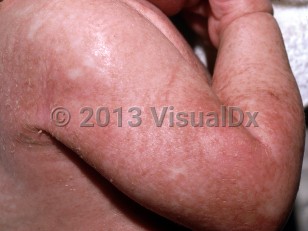These deficiencies are screened for in all newborns in the United States and several other countries. Biotinidase deficiency has an overall incidence of about 1:60 000 newborns. In California, biotinidase deficiency has a higher incidence in Hispanics of Mexican descent. The disorder has been found worldwide in all populations and ethnic groups.
Biotinidase deficiency can be profound or partial; profound and partial deficiencies of biotinidase are the most common forms of the multiple carboxylase-related deficiencies.
Profound biotinidase deficiency – Mean age of onset is 3.5 months; onset often occurs by 1 week of age. If untreated, patients may develop the following:
- Seizures (often myoclonic) and hypotonia
- Sensorineural deafness, ataxia and optic atrophy, and developmental delay
- Hyperventilation, respiratory stridor, and apnea
- Alopecia (rarely, trichorrhexis changes have been reported in remaining hairs)
- Perioral and periorificial eruptions than can be generalized, cutaneous Candida infections, and conjunctivitis
- Metabolic changes including keto-lactic acidosis, organic aciduria and increased ammonia levels, and hypoglycemia
Holocarboxylase synthetase deficiency and defects in the other carboxylases are often detected by neonatal screening programs analyzing organic acids.



